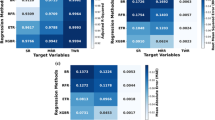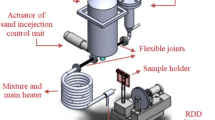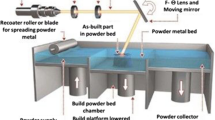Abstract
The models, simulation, and validation were presented during the last decade over various moving particle investigations with thermal convection and disclosed the challenges as well. The present work provides the simulation and validation of the grinding mechanism of high-temperature nickel-based alloy with single abrasive grain. Several nickel-based alloys provide better performances for temperatures above 1000 °C and those suited for extremely difficult conditions as well. In this study, we simulate and analyze the grinding mechanism of high-temperature nickel-based alloy using single abrasive grain cutting. Using a grinding, it introduces variation in friction coefficient as per the variations of the grinding parameters. The grinding force system of single abrasive grain is designed and simulated to investigate high-temperature nickel-based alloy using various grinding conditions like particle settling modes such as rolling, horizontal, and vertical with thermal convection. The multi-grid finite element fictitious boundary method (FEM-FBM) is used to simulate and study the grinding mechanism of high-temperature nickel-based alloy in terms of fluid-particle sedimentations. The material used for this simulation study is Inconel 718 alloy. The simulation results investigate the various grinding force conditions of high-temperature nickel-based 718 alloys using the dimensional physical parameters and numbers such as Prandtl number and Grashof number. Finally, the simulation results were validated with a conventional FEM model.












Similar content being viewed by others
References
Feng J, Huang PY, Joseph DD (1995) Dynamic simulation of the motion of capsules in pipelines. J Fluid Mech 286(1):201. https://doi.org/10.1017/s002211209500070x
Feng J, Joseph DD (1995) The unsteady motion of solid bodies in creeping flows. J Fluid Mech 303(1):83. https://doi.org/10.1017/s0022112095004186
Feng J, Hu HH, Joseph DD (1994) Direct simulation of initial value problems for the motion of solid bodies in a Newtonian fluid. Part 1. Sedimentation. J Fluid Mech 261(1):95. https://doi.org/10.1017/s0022112094000285
Feng J, Hu HH, Joseph DD (1994) Direct simulation of initial value problems for the motion of solid bodies in a Newtonian fluid. Part 2. Couette and Poiseuille flows. J Fluid Mech 277(1):271. https://doi.org/10.1017/s0022112094002764
Feng Z-G, Michaelides EE (2004) The immersed boundary-lattice Boltzmann method for solving fluid–particles interaction problems. J Comput Phys 195(2):602–628. https://doi.org/10.1016/j.jcp.2003.10.013
Hu HH, Joseph DD, Crochet MJ (1992) Direct simulation of fluid particle motions. Theor Comput Fluid Dyn 3(5):285–306. https://doi.org/10.1007/bf00717645
Huang PY, Feng J, Joseph DD (1994) The turning couples on an elliptic particle settling in a vertical channel. J Fluid Mech 271:1–16. https://doi.org/10.1017/s0022112094001667
Huang PY, Hu HH, Joseph DD (1998) Direct simulation of the sedimentation of elliptic particles in Oldroyd-B fluids. J Fluid Mech 362:297–326. https://doi.org/10.1017/s0022112098008672
Prosperetti A, Og̃uz HN (2001) Physalis: a new o(N) method for the numerical simulation of disperse systems: potential flow of spheres. J Comput Phys 167(1):196–216. https://doi.org/10.1006/jcph.2000.6667
Uhlmann M (2005) An immersed boundary method with direct forcing for the simulation of particulate flows. J Comput Phys 209(2):448–476. https://doi.org/10.1016/j.jcp.2005.03.017
Lai M-C, Peskin CS (2000) An immersed boundary method with formal second-order accuracy and reduced numerical viscosity. J Comput Phys 160(2):705–719. https://doi.org/10.1006/jcph.2000.6483
Mo H, Lien F-S, Zhang F, Cronin DS (2018) An immersed boundary method for solving compressible flow with arbitrarily irregular and moving geometry. Int J Numer Methods Fluids 88:239–263. https://doi.org/10.1002/fld.4665
Haeri S, Shrimpton JS (2013) A new implicit fictitious domain method for the simulation of flow in complex geometries with heat transfer. J Comput Phys 237:21–45. https://doi.org/10.1016/j.jcp.2012.11.050
Turek S, Wan D, Rivkind LS (2003) The fictitious boundary method for the implicit treatment of Dirichlet boundary conditions with applications to incompressible flow simulations. In: Bänsch E (ed) Challenges in scientific computing - CISC 2002. Lecture Notes in Computational Science and Engineering, vol 35. Springer, Berlin. https://doi.org/10.1007/978-3-642-19014-8_3
Wan D, Turek S (2006) Direct numerical simulation of particulate flow via multigrid FEM techniques and the fictitious boundary method. Int J Numer Methods Fluids 51(5):531–566. https://doi.org/10.1002/fld.1129
Wan D, Turek S, Rivkind LS (2004) An efficient multigrid FEM solution technique for incompressible flow with moving rigid bodies. In: Feistauer M, Dolejší V, Knobloch P, Najzar K (eds) Numerical mathematics and advanced applications. Springer, Berlin. https://doi.org/10.1007/978-3-642-18775-9_83
Wan D, Turek S (2007) An efficient multigrid-FEM method for the simulation of solid–liquid two phase flows. J Comput Appl Math 203(2):561–580. https://doi.org/10.1016/j.cam.2006.04.021
MacMeccan RM, Clausen JR, Neitzel GP, Aidun CK (2008) Simulating deformable particle suspensions using a coupled lattice-Boltzmann and finite-element method. J Fluid Mech 618:13–39. https://doi.org/10.1017/s0022112008004011
Feng YT, Han K, Owen DRJ (2009) Combined three-dimensional lattice Boltzmann method and discrete element method for modelling fluid-particle interactions with experimental assessment. Int J Numer Methods Eng 81:229–245. https://doi.org/10.1002/nme.2689
Hager A, Kloss C, Pirker S, Goniva C (2012) Parallel open source CFD-DEM for resolved particle-fluid interaction. 1–6.
Sun R, Xiao H (2016) SediFoam: a general-purpose, open-source CFD–DEM solver for particle-laden flow with emphasis on sediment transport. Comput Geosci 89:207–219. https://doi.org/10.1016/j.cageo.2016.01.011
Kim J, Choi H (2004) An immersed-boundary finite-volume method for simulation of heat transfer in complex geometries. KSME Int J 18(6):1026–1035. https://doi.org/10.1007/bf02990875
Pacheco JR, Pacheco-Vega A, Rodić T, Peck RE (2005) Numerical simulations of heat transfer and fluid flow problems using an immersed-boundary finite-volume method on nonstaggered grids. Numer Heat Transfer Part B 48(1):1–24. https://doi.org/10.1080/10407790590935975
Demirdžić I, Lilek Ž, Perić M (1992) Fluid flow and heat transfer test problems for non-orthogonal grids: bench-mark solutions. Int J Numer Methods Fluids 15(3):329–354. https://doi.org/10.1002/fld.1650150306
Gan H, Chang J, Feng JJ, Hu HH (2003) Direct numerical simulation of the sedimentation of solid particles with thermal convection. J Fluid Mech 481:385–411. https://doi.org/10.1017/s0022112003003938
Gan H, Feng JJ, Hu HH (2003) Simulation of the sedimentation of melting solid particles. Int J Multiphase Flow 29(5):751–769. https://doi.org/10.1016/s0301-9322(03)00035-1
Yu Z, Shao X, Wachs A (2006) A fictitious domain method for particulate flows with heat transfer. J Comput Phys 217(2):424–452. https://doi.org/10.1016/j.jcp.2006.01.016
Feng Z-G, Michaelides EE (2008) Inclusion of heat transfer computations for particle laden flows. Phys Fluids 20(4):040604. https://doi.org/10.1063/1.2911022
Feng Z-G, Musong SG (2014) Direct numerical simulation of heat and mass transfer of spheres in a fluidized bed. Powder Technol 262:62–70. https://doi.org/10.1016/j.powtec.2014.04.019
Tavassoli H, Kriebitzsch SHL, van der Hoef MA, Peters EAJF, Kuipers JAM (2013) Direct numerical simulation of particulate flow with heat transfer. Int J Multiphase Flow 57:29–37. https://doi.org/10.1016/j.ijmultiphaseflow.2013.06.009
Seddeek M, Afify A, Al A (2009) Similarity solutions for a steady MHD Falkner-Skan flow and heat transfer over a wedge considering the effects of variable viscosity and thermal conductivity. Applications and Applied Mathematics [electronic only]:4
Rietema K, van den Akker HEA (1983) On the momentum equations in dispersed two-phase systems. Int J Multiphase Flow 9(1):21–36. https://doi.org/10.1016/0301-9322(83)90004-6
Osiptsov A (1997) Mathematical modeling of dusty-gas boundary layers. Appl Mech Rev 50:357–370. https://doi.org/10.1115/1.3101716
Palani G, Ganesan P (2007) Heat transfer effects on dusty gas flow past a semi-infinite inclined plate. Forsch Ingenieurwes 71(3-4):223–230. https://doi.org/10.1007/s10010-007-0061-9
Majlesara M, Abouali O, Kamali R (2020) Fully resolved numerical simulation of free convection of falling spherical particles in sedimentation transports using immersed boundary method. Iran J Sci Technol Trans Mech Eng. https://doi.org/10.1007/s40997-020-00348-7
Feng Z-G, Michaelides EE (2009) Heat transfer in particulate flows with direct numerical simulation (DNS). Int J Heat Mass Transf 52(3-4):777–786. https://doi.org/10.1016/j.ijheatmasstransfer.2008.07.023
Deen NG, Kriebitzsch SHL, van der Hoef MA, Kuipers JAM (2012) Direct numerical simulation of flow and heat transfer in dense fluid–particle systems. Chem Eng Sci 81:329–344. https://doi.org/10.1016/j.ces.2012.06.055
Hu J, Guo Z (2017) A numerical study on the migration of a neutrally buoyant particle in a Poiseuille flow with thermal convection. Int J Heat Mass Transf 108:2158–2168. https://doi.org/10.1016/j.ijheatmasstransfer.2017.01.077
Walayat K, Wang Z, Usman K, Liu M (2018) An efficient multi-grid finite element fictitious boundary method for particulate flows with thermal convection. Int J Heat Mass Transf 126:452–465. https://doi.org/10.1016/j.ijheatmasstransfer.2018.05.007
Xu A, Shi L, Zhao TS (2018) Thermal effects on the sedimentation behavior of elliptical particles. Int J Heat Mass Transf 126:753–764. https://doi.org/10.1016/j.ijheatmasstransfer.2018.05.073
Walayat K, Zhang Z, Usman K, Chang J, Liu M (2018) Dynamics of elliptic particle sedimentation with thermal convection. Phys Fluids 30(10):103301. https://doi.org/10.1063/1.5051817
Kuai J, Zhang H, Zhang F (2010) Grinding force model of single abrasive grain based on variable friction coefficient. In: Fourth International Seminar on Modern Cutting and Measurement Engineering. https://doi.org/10.1117/12.888621
Anderson D, Warkentin A, Bauer R (2011) Experimental and numerical investigations of single abrasive-grain cutting. Int J Mach Tools Manuf 51(12):898–910. https://doi.org/10.1016/j.ijmachtools.2011.08.006
Wang S, Li C, Zhang X et al (2014) Modeling and simulation of the single grain grinding process of the nano-particle jet flow of minimal quantity lubrication. Open Mater Sci J 2014(8):55–62
Setti D, Ghosh S, Paruchuri VR (2016) Influence of nanofluid application on wheel wear, coefficient of friction and redeposition phenomenon in surface grinding of Ti-6Al-4V. Proc Inst Mech Eng B J Eng Manuf 232(1):128–140. https://doi.org/10.1177/0954405416636039
Chen X, Öpöz TT (2016) Effect of different parameters on grinding efficiency and its monitoring by acoustic emission. Prod Manuf Res 4(1):190–208. https://doi.org/10.1080/21693277.2016.1255159
Ardashev DV, Dyakonov AA (2017) Mathematical model of the grinding force with account for blunting of abrasive grains of the grinding wheel. J Manuf Sci Eng 139(12):121005. https://doi.org/10.1115/1.4037939
Wang Q, Zhao W, Liang Z, Wang X, Zhou T, Wu Y, Jiao L (2018) Investigation of diamond wheel topography in elliptical ultrasonic assisted grinding (EUAG) of monocrystal sapphire using fractal analysis method. Ultrasonics 84:87–95. https://doi.org/10.1016/j.ultras.2017.10.012
Kovač P, Gostimirović M (2018) Grinding force of cylindrical and creep-feed grinding modeling. Abrasive Technology - Characteristics and Applications. https://doi.org/10.5772/intechopen.76968
Li Z, Zhang F, Luo X, Guo X, Cai Y, Chang W, Sun J (2018) A new grinding force model for micro grinding RB-SiC ceramic with grinding wheel topography as an input. Micromachines 9(8):368. https://doi.org/10.3390/mi9080368
Ni J, Feng K, Al-Furjan MSH, Xu X, Xu J (2019) Establishment and verification of the cutting grinding force model for the disc wheel based on piezoelectric sensors. Sensors 19(3):725. https://doi.org/10.3390/s19030725
Adiyaman O, Demir Z (2019) Model and formulation in grinding mechanism having advanced secondary rotational axis. Meas Control 52:326–337. https://doi.org/10.1177/0020294019837988
Salonitis K, Stournaras A, Stavropoulos P, Chryssolouris G (2007) Finite element modeling of grind hardening process. In: 10th CIRP International Workshop on Modeling of Machining Operations, Calabria, Italy, pp 117–123
Salonitis K, Tsoukantas G, Stavropoulos P, Stournaras A, Chondros T, Chryssolouris G (2006) Process forces modelling in grind-hardening. In: 9th CIRP International Workshop on Modeling of Machining Operations, Bled, Slovenia, pp 295–302
Yi J, Jin T, Deng Z, Zhou W (2019) Estimation of residual stresses in gear form grinding using finite element analysis and experimental study based on grinding force and heat flux distribution models. Int J Adv Manuf Technol 104:849–866. https://doi.org/10.1007/s00170-019-03825-9
Wang Z, Li Y, Yu T, Zhao J, Wen PH (2018) Prediction of 3D grinding temperature field based on meshless method considering infinite element. Int J Adv Manuf Technol 100:3067–3084. https://doi.org/10.1007/s00170-018-2801-4
Author information
Authors and Affiliations
Corresponding author
Additional information
Publisher’s note
Springer Nature remains neutral with regard to jurisdictional claims in published maps and institutional affiliations.
Rights and permissions
About this article
Cite this article
Al-Nehari, M., Liang, G., Ming, L. et al. Grinding mechanism of high-temperature nickel-based alloy using FEM-FBM technique. Int J Adv Manuf Technol 112, 87–105 (2021). https://doi.org/10.1007/s00170-020-06328-0
Received:
Accepted:
Published:
Issue Date:
DOI: https://doi.org/10.1007/s00170-020-06328-0




